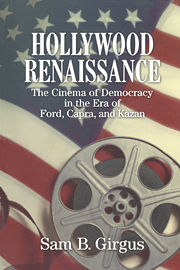Book contents
- Frontmatter
- Contents
- List of Illustrations
- Acknowledgments
- 1 Ethnics and Roughnecks: The Making of the Hollywood Renaissance
- 2 A Cinema for Democracy: John Ford and the Crisis of Modernity, Myth, and Meaning
- 3 Gender and American Character: Frank Capra
- 4 Revisioning Heroic Masculinity: From Ford to Hawks and Zinnemann
- 5 An American Conscience: Elia Kazan's Long Journey Home
- 6 Losing Tomorrow: George Stevens and the American Idea
- 7 Conclusion: Film and America after the Hollywood Renaissance
- Notes
- Filmography
- Index
6 - Losing Tomorrow: George Stevens and the American Idea
Published online by Cambridge University Press: 05 June 2012
- Frontmatter
- Contents
- List of Illustrations
- Acknowledgments
- 1 Ethnics and Roughnecks: The Making of the Hollywood Renaissance
- 2 A Cinema for Democracy: John Ford and the Crisis of Modernity, Myth, and Meaning
- 3 Gender and American Character: Frank Capra
- 4 Revisioning Heroic Masculinity: From Ford to Hawks and Zinnemann
- 5 An American Conscience: Elia Kazan's Long Journey Home
- 6 Losing Tomorrow: George Stevens and the American Idea
- 7 Conclusion: Film and America after the Hollywood Renaissance
- Notes
- Filmography
- Index
Summary
Women and Men of the Year
The five directors discussed in this study so far were all instrumental in creating a special period of artistic innovation in American cultural and film history. Beginning in the mid-1930s, John Ford, Frank Capra, Howard Hawks, Fred Zinnemann, and Elia Kazan achieved the kind of cultural renewal through film that earlier generations of Americans accomplished in literature, art, and thought. They created a democratic cinema of aesthetic complexity and depth during a time of extended and deadly challenge to democracy by totalitarianism abroad and antidemocratic movements at home. In contrast to the propagandistic cinema of totalitarian regimes, ideology and art cohere in their films to appeal to and challenge the general public as well as sophisticated cinéphiles of film and modernism. Advancing cinema as a heterogeneous art form of multiple channels of expression, these directors in the renaissance made films that are intertwined with American life, sometimes repeating and dramatizing some of the worst elements of the culture, such as the perpetuation of racist ways of thinking and acting. Thus, the artistic genius of these filmmakers and their focus on America make them the core of the Hollywood Renaissance.
George Stevens completes this group of directors. American culture, character, and history form the heart of Stevens's cinematic consciousness. His career extends from the era of classic Hollywood cinema to his less significant work during the last days of the Hollywood Renaissance in the mid-1960s.
- Type
- Chapter
- Information
- Hollywood RenaissanceThe Cinema of Democracy in the Era of Ford, Kapra, and Kazan, pp. 177 - 209Publisher: Cambridge University PressPrint publication year: 1998



